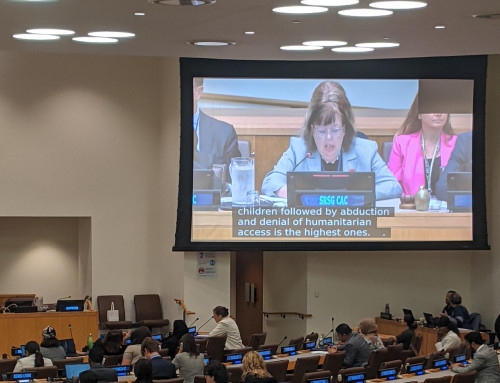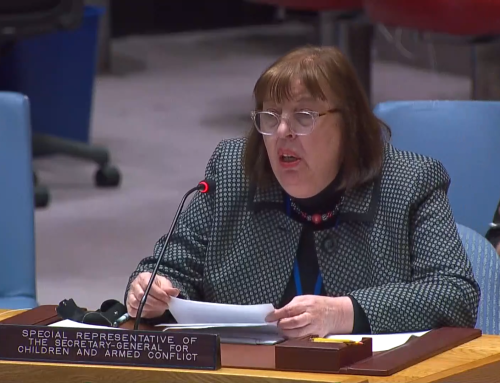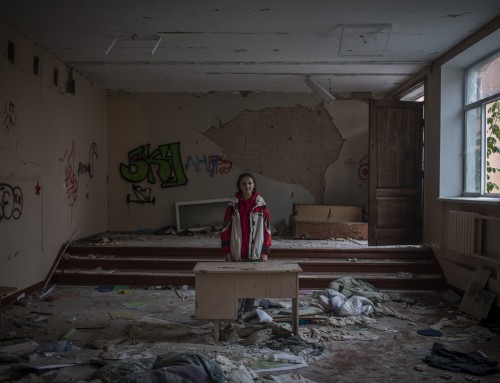Excellencies, Colleagues, Ladies and Gentlemen
In the year of the 25th anniversary of the Convention on the Rights of the Child, it is important that we look back at the enormous progress we have made together in building solid legal, policy and operational frameworks to protect children from the impact of armed conflict.
As an international community, we also have to recognize the continuing shortcomings and challenges that we face in keeping children safe from harm.
This past year has brought great suffering to children affected by armed conflicts around the world. Fifty-one million people, the majority of them women and children, were displaced globally at the end of 2013 with an additional 2.5 million in the first six months of 2014 alone. Situations of protracted conflict such as in Somalia, Afghanistan and eastern DRC, as well as large scale emergencies in Syria, the Central African Republic, South Sudan, Iraq and in Gaza have taken a dramatic toll on children.
The intensity of fighting in recent months has reached unprecedented levels in many situations. Children are the primary victims: they have been killed, maimed, used and recruited, targeted and brutalized by armed forces and groups. In Syria alone, 6.5 million children have been affected by the conflict. In South Sudan, since the crisis started in December 2013, both parties to the conflict have committed grave violations against children. 1.4 million people have been displaced and an additional 463,000 have sought refuge outside of the country. Thousands of children are currently separated from their families. They are homeless and at great risk of becoming victims of grave violations.
The wave of armed groups espousing extremist ideologies sweeping across northern Mali, Iraq, Syria and Nigeria is posing additional threats to children, who are often indoctrinated to fight in the name of radical ideologies. Children’s association with extremist armed groups is also posing new challenges to child protection actors, especially when counter-terrorism measures are applied to children with little or no consideration for their age. Another challenge is reintegrating them back into society, which requires special care and psycho-social assistance that are not always available.
I remain gravely concerned by the continuing trend of detention of children on security charges in many situations of conflict. Children should be regarded primarily as victims and should not be detained solely for association with an armed group.
Excellencies, ladies and gentlemen
I am appalled by the alarming trend of attacks on education and health care facilities. The recent bombing of a school in Homs, Syria, where the majority of the victims were children, is only the most recent example of the deliberate targeting of schoolchildren, teachers and educational institutions. In some cases, these attacks aim to maximize civilian casualties—a serious breach of international humanitarian law, and an immoral, despicable tactic.
In Nigeria, Boko Haram is inflicting brutal suffering on young people, directly targeting education as a tactic of warfare. The abduction of the schoolgirls in the northern town of Chibok, already six months ago, has shocked the world but has also shown that there are gaps in protection mechanisms for children in these situations—which we must remedy. In Yemen, the renewed instability in the capital city of Sana’a has put over 75,000 children out of school and affected 51 educational facilities.
The choice of Malala Yousafzai as this year’s Nobel Prize winner sends a message that the world community prioritizes protecting education for all schoolchildren, and that together we must act to ensure that children affected by conflict can continue to learn and build a brighter future.
Excellencies,
Throughout my visits to the field over the past year in the CAR, DRC, Somalia, South Sudan and Yemen, I have continued to engage actively with all stakeholders to promote and facilitate the implementation of their commitments to protect children from the harm of conflict. In South Sudan, I witnessed the signature of a recommitment agreement by the Government to end and prevent the recruitment and use of children, and other grave violations, by its armed forces. In Yemen, I attended the signing of an Action Plan with the United Nations, to end recruitment and use of children by national security forces. My visit to Somalia, represented an opportunity to evaluate challenges and identify opportunities to support the government in fulfilling its obligations under the action plan in a complex security environment; while in the CAR my visit aimed at assessing first-hand the tragic impact of conflict on children and identifying ways to better support child protection partners in dealing with the crisis.
Excellencies, Ladies and Gentlemen
This year, the children and armed conflict agenda continued to witness important progress.
In March, 8 governments listed in the Annexes of the Secretary-General report for recruitment and use of children joined the campaign, ‘Children not Soldiers’, which I launched in partnership with UNICEF to end and prevent the recruitment and use of children by government forces by 2016.
I am very pleased to report that we have – together – already achieved tangible progress: the Armée Nationale Tchadienne was de-listed and, as just mentioned, the Government of Yemen signed an Action Plan. In Somalia, a joint screening of the Somalia National Army was undertaken and child protection units were established by the Ministry of Defense.
Furthermore, the Government of Afghanistan has signed a roadmap to accelerate compliance with its action plan and criminalized under-age recruitment. In Myanmar, I am pleased to note that over 200 children were recently released under the Government’s action plan. In the DRC, the implementation continues to progress.
To broaden ownership of the campaign ‘Children, Not Soldiers’ we also held a series of consultations with governments to exchange information on good practices and with civil society to identify ways to maximize impact by working together in support of the governments’ efforts. I am grateful for the role that key international and regional partners, as well as civil society, continue to play not only in the context of the campaign but more broadly in support of my mandate. I urge the donor community to support this campaign generously as these countries are willing to move towards making the recruitment of children a practice of the past, but lack sufficient resources to realize that goal.
Excellencies, ladies and gentlemen, dear colleagues,
While I am pleased to report on the progress made with Member States, I shall also note the continuing challenge of addressing the problem of non-state actors. Fifty-one non-state armed groups remain listed in the Annexes of the Secretary-General’s annual report on Children and Armed Conflict. During the reporting period we have continued to engage with these parties and dialogue is currently underway with groups in the CAR, Mali, Myanmar, South Sudan, Darfur, Syria and Yemen.
I strongly encourage governments to support the work of child protection actors and to facilitate access for the purpose of establishing dialogue and in verifying implementation of commitments made by these groups.
Excellencies, ladies and gentlemen
Partnership and collaboration has remained central to my mandate. Only by leveraging our comparative advantages do we stand a chance of overcoming the daunting challenge of protecting children affected by today’s conflicts. This year, my Office and UNICEF engaged in mainstreaming child protection with our AU partners. A child protection advisor is now deployed within the Department of Peace and Security of the African Union Commission.
In May, I had the honor of briefing the AU Peace and Security Council at its first Open Session on children and armed conflict. I was encouraged by the commitment and determination of the Member States to work together to strengthen child protection systems.
I am also pleased to report that on 22 September the United Nations signed a partnership agreement with the League of Arab States to develop a framework for joint actions for the protection of children affected by armed conflict.
We also continued to cement our collaboration with United Nations partners. This year, together with UNESCO, UNICEF and WHO, we developed a guidance note to strengthen advocacy, monitoring and reporting on attacks on schools and hospitals by providing key definitions and practical advice.
I am confident that all of these partnerships will continue to grow and benefit our shared goal of protecting children in conflict situations.
Excellencies,
157 Member States have ratified the Optional Protocol on the Involvement of Children in Armed Conflict (OPAC) to date. Allow me to seize the opportunity of being here today to call on those who have not yet done so, to take steps towards ratification.
I commend UNICEF and UNHCR for their initiatives in providing access to education in emergencies and I call on donors to sustain these efforts and replicate them in other contexts. I also call on all stakeholders to increase focus and resources on community-based reintegration initiatives that can provide children with sustainable options.
I would also like to take this opportunity to thank our generous donor countries, whose support allows us to carry out our mandate even more effectively. We welcome additional support from countries to help us better assist to end violations against children.
Excellencies, ladies and gentlemen,
In the next year, with your support, I intend to continue to pursue a multidimensional approach in the implementation of my mandate. I will use all possible fora within the UN, regional organizations and bilaterally, to strengthen existing child protection frameworks, including by supporting initiatives that can respond to the increasing new challenges posed to child protection in conflict situations.
Thank you.





